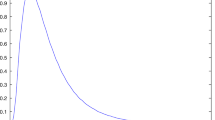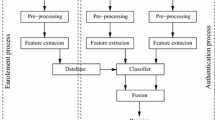Abstract
The selection of the optimal feature subset and the classification has become an important issue in the field of iris recognition. In this paper we propose several methods for iris feature subset selection and vector creation. In this paper we propose a new feature extraction method for iris recognition based on contourlet transform. Contourlet transform captures the intrinsic geometrical structures of iris image. For reducing the feature vector dimensions we use the method for extract only significant bit and information from normalized iris images. In this method we ignore fragile bits. At last, the feature vector is created by two methods: Co-occurrence matrix properties and contourlet coefficients. For analyzing the desired performance of our proposed method, we use the CASIA dataset, which is comprised of 108 classes with 7 images in each class and each class represented a person. Experimental results show that the proposed increase the classification accuracy and also the iris feature vector length is much smaller versus the other methods.
Preview
Unable to display preview. Download preview PDF.
Similar content being viewed by others
References
Wildes, R.P.: Iris recognition: an emerging biometric technology. Proceedings of the IEEE 85(9), 1348–1363 (1997)
Jain, A., Bolle, R., Pankanti, S.: Biometrics: Personal Identification in a Networked Society. Kluwer Academic Publishers, Norwell (1999)
Daugman, J.: Biometric personal identification system based on iris analysis, US patent no. 5291560 (1994)
Mansfield, T., Kelly, G., Chandler, D., Kane, J.: Biometric product testing. Final Report, National Physical Laboratory, Middlesex, U.K (2001)
Daugman, J.G.: High confidence visual recognition of persons by a test of statistical independence. IEEE Transactions on Pattern Analysis and Machine Intelligence 15(11), 1148–1161 (1993)
Daugman, J.: Demodulation by complex-valued wavelets for stochastic pattern recognition. International Journal of Wavelets, Multiresolution and Information Processing 1(1), 1–17 (2003)
CASIA, Chinese Academy of Sciences – Institute of Automation. Database of 756 Grayscale Eye Images. Versions 1.0 (2003), http://www.sinobiometrics.com
He, X., Shi, P.: An efficient iris segmentation method for recognition. In: Singh, S., Singh, M., Apte, C., Perner, P. (eds.) ICAPR 2005. LNCS, vol. 3687, pp. 120–126. Springer, Heidelberg (2005)
Bae, K., Noh, S., Kim, J.: Iris feature extraction using independent component analysis. In: Kittler, J., Nixon, M.S. (eds.) AVBPA 2003. LNCS, vol. 2688, pp. 1059–1060. Springer, Heidelberg (2003)
Boles, W.W., Boashash, B.: A human identification technique using images of the iris and wavelet transform. IEEE Transactions on Signal Processing 46(4), 1185–1188 (1998)
Chong, S.C., Teoh, A.B.J., Ngo, D.C.L.: Iris authentication using privatized advanced correlation filter. In: Zhang, D., Jain, A.K. (eds.) ICB 2005. LNCS, vol. 3832, pp. 382–388. Springer, Heidelberg (2005)
Daugman, J.: Statistical richness of visual phase information: update on recognizing persons by iris patterns. International Journal of Computer Vision 45(1), 25–38 (2001)
He, X., Shi, P.: An efficient iris segmentation method for recognition. In: Singh, S., Singh, M., Apte, C., Perner, P. (eds.) ICAPR 2005. LNCS, vol. 3687, pp. 120–126. Springer, Heidelberg (2005)
Jeong, D.S., Park, H.-A., Park, K.R., Kim, J.: Iris recognition in mobile phone based on adaptive Gabor filter. In: Zhang, D., Jain, A.K. (eds.) ICB 2005. LNCS, vol. 3832, pp. 457–463. Springer, Heidelberg (2005)
Vijaya Kumar, B.V.K., Xie, C., Thornton, J.: Iris verification using correlation filters. In: Kittler, J., Nixon, M.S. (eds.) AVBPA 2003. LNCS, vol. 2688, pp. 697–705. Springer, Heidelberg (2003)
Lee, E.C., Park, K.R., Kim, J.: Fake iris detection by using purkinje image. In: Zhang, D., Jain, A.K. (eds.) ICB 2005. LNCS, vol. 3832, pp. 397–403. Springer, Heidelberg (2005)
Lim, S., Lee, K., Byeon, O., Kim, T.: Efficient iris recognition through improvement of feature vector and classifier. Electronics and Telecommunications Research Institute Journal 23(2), 61–70 (2001)
Liu, X., Bowyer, K.W., Flynn, P.J.: Experiments with an improved iris segmentation algorithm. In: Proceedings of the 4th IEEE Workshop on Automatic Identification Advanced Technologies (AUTO ID 2005), Buffalo, NY, USA, October 2005, pp. 118–123 (2005)
Liu, X., Bowyer, K.W., Flynn, P.J.: Experimental evaluation of iris recognition. In: Proceedings of the IEEE Computer Society Conference on Computer Vision and Pattern Recognition (CVPR 2005), San Diego, Calif, USA, June 2005, vol. 3, pp. 158–165 (2005)
Ma, L., Tan, T., Wang, Y., Zhang, D.: Personal identification based on iris texture analysis. IEEE Transactions on Pattern Analysis and Machine Intelligence 25(12), 1519–1533 (2003)
Daugman, J.: How Iris Recognition works. IEEE Transactions on Circuits and systems for video Technology 14(1), 21–30 (2004)
Ali, J.M.H., Hussanien, A.E.: An Iris Recognition System to Enhance E-security Environment Based on Wavelet Theory. AMO - Advanced Modeling and Optimization 5(2) (2003)
Do, M.N., Vetterli, M.: The contourlet transform: An Efficient directional multiresolution image representation. IEEE Transactions on Image Processing 14(12), 2091–2106
Burt, P.J., Adelson, E.H.: The Laplacian pyramid as a compact image code. IEEE Trans. Commun. 31(4), 532–540 (1983); Bamberger, R.H., Smith, M.J.T.: A filter bank for the directional decomposition of images: Theory and design. IEEE Trans. Signal Proc. 40(4), 882–893 (1992)
Hollingsworth, K.P., Bowyer, K.W.: The Best Bits in an Iris Code. IEEE Transactions on Pattern Analysis and Machine Intelligence (PAMI) (April 2008)
Haralick, R.M., Shanmugam, K., Din, L.: Textural features for image classification. IEEE Transactions on Systems, Man, and Cybernetics 3(6), 610–621 (1973)
Author information
Authors and Affiliations
Editor information
Editors and Affiliations
Rights and permissions
Copyright information
© 2009 Springer-Verlag Berlin Heidelberg
About this paper
Cite this paper
Azizi, A., Pourreza, H.R. (2009). A Novel and Efficient Method to Extract Features and Vector Creation in Iris Recognition System. In: Mertsching, B., Hund, M., Aziz, Z. (eds) KI 2009: Advances in Artificial Intelligence. KI 2009. Lecture Notes in Computer Science(), vol 5803. Springer, Berlin, Heidelberg. https://doi.org/10.1007/978-3-642-04617-9_15
Download citation
DOI: https://doi.org/10.1007/978-3-642-04617-9_15
Publisher Name: Springer, Berlin, Heidelberg
Print ISBN: 978-3-642-04616-2
Online ISBN: 978-3-642-04617-9
eBook Packages: Computer ScienceComputer Science (R0)




